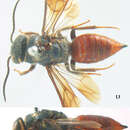Description
provided by Zookeys
Holotype, ♀, length of body 15.2 mm (of fore wing 10.6 mm).
Head. Antenna with 12 segments and penultimate segment 1.2 times as wide as apical segment in dorsal view (Fig. 18); frons rather coarsely reticulate-rugose; vertex coarsely reticulate-punctate (Fig. 21); temple coarsely punctate; malar space densely punctulate; head directly narrowed behind eyes (Fig. 21); clypeus coarsely punctate and dorsally with median crest (Fig. 20).
Mesosoma. Length of mesosoma 1.5 times its height (Fig. 14); mesopleuron largely coarsely reticulate; metapleuron densely punctulate anteriorly and coarsely obliquely costate posteriorly, with a moderately wide smooth shiny band above it (Fig. 17); pronotum, mesoscutum, scutellum and metanotum coarsely reticulate-punctate, smooth interspaces between punctures of pronotum and metanotum medio-dorsally mostly distinctly narrower than diameter of punctures (Fig. 16); metanotum medially distinctly convex and distinctly protruding above level of scutellum (Figs 14, 17); entire propodeum densely and rather coarsely reticulate-rugose (Fig. 16).
Wings. Fore wing: vein 2m-cu far postfurcal (Fig. 15).
Legs. Hind basitarsus rather slender (Fig. 19).
Metasoma. Metasoma rather wide in dorsal view (Fig. 13); basal tergites finely punctate and shiny, with smooth interspaces wider than diameter of punctures (Fig. 13); hypopygium 1.2 times longer than fifth sternite ventrally (Fig. 14); ovipositor unknown (broken in holotype).
Colour. Black; ivory: L-shaped lateral patch on clypeus, patch at incision of eye extending nearly up to level of anterior ocellus (Fig. 20), shelf of frons anteriorly between antennal sockets, temple (except posteriorly) and up to upper level of eye (Fig. 22), transverse stripe on pronotum (except wide interruption medially; Fig. 16, and narrowed ventrally), small patch on mesopleuron antero-dorsally, minute patch near tegula, axilla, lateral patch on metanotum, apical patch on fore femur and small basal patch on fore tibia; metasoma dark red; palpi brown; tarsi yellowish-brown; remainder of femora and tibiae, veins and pterostigma, dark brown; fore coxa densely golden setose; apical 0.6 of fore wing dark brown and remainder subhyaline (Fig. 15).
Male. Unknown.
- license
- cc-by-3.0
- copyright
- Cornelis van Achterberg
- bibliographic citation
- van Achterberg C (2014) Revision of the genus Parasapyga Turner (Hymenoptera, Sapygidae), with the description of two new species ZooKeys 369: 61–77
- author
- Cornelis van Achterberg

